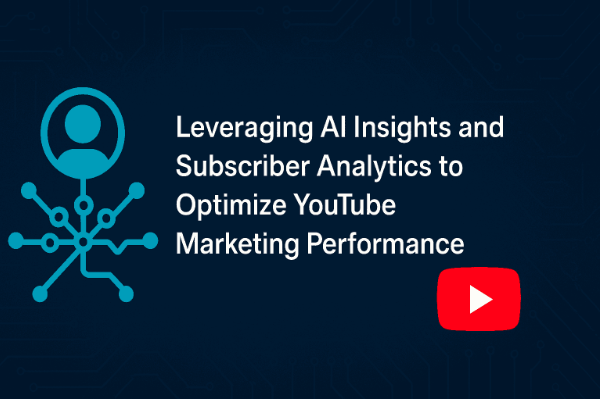
I’ve seen creators burn out not from lack of creativity, but from the wrong kind of guessing. They post a video, wait, and hope. That’s not a strategy. That’s roulette. I’ve learned, through trial and repeat headaches, that AI isn’t here to replace instinct — it sharpens it. It turns blurry impressions into usable truths.
What does that even mean, though? At its best, AI deciphers what human viewers often can’t articulate: why they clicked, why they stayed, and why they left. These aren’t mysteries anymore. With the right tools, you can trace the behavior of every subscriber down to their last reaction. And once I started tuning in to that data, the patterns got louder.
Tracking Subscribers in Real Time
One of the first things I changed in my workflow was obsessing less over vanity metrics and more over how real-time changes in subscriber count reflected performance. A stagnant number told me more than I expected, especially when a high-performing video was live.
There were moments where I thought, This one will go viral, and then watched my count freeze. That was my cue when something was off. On the flip side, some of my best growth came from quiet uploads that hit the right niche. And the reason I noticed? I kept a live YouTube counter open, and when my subs jumped by over 17% in under an hour, I dug into why — audience retention was double my average, and traffic sources leaned heavy on search.
That’s when I realized the live counter wasn’t just a novelty — it was my early warning system. It told me when something clicked before the analytics dashboard ever could. A sudden surge wasn’t just exciting; it meant my content struck the right chord. It pushed me to dig deeper, tweak what wasn’t working, and lean into what was. Over time, the subscriber count became less about milestone chasing and more about real-time feedback — a reflection of whether I was truly connecting with the audience in that moment.
That spike taught me more than any YouTube Academy course ever could.
Let the Data Argue with You
It stings a little when your favorite idea flops. But AI doesn’t care about ego. It only cares about patterns. I once planned a high-production upload around trending news, thinking timeliness alone would carry it. It didn’t. The algorithm showed a massive drop-off within the first 45 seconds. Turns out, no one cared about the intro story arc.
After feeding that data into an AI tool I use, it recommended shorter intros and a switch-up in pacing — literally flagging segments that caused viewer fatigue. I applied that in the next upload, even though I wasn’t fully sold. The result? My average view duration jumped by 32%, and I finally beat the recommendation engine ceiling that had haunted me for months.
So yeah, the algorithm might not clap for your effort — but it will reward clarity.
Every Subscriber Isn’t Equal
Let me be brutally honest here: having 100k subscribers means nothing if 80k of them are ghosts. AI analytics exposed that uncomfortable truth in the second year of my channel. When I stopped looking at raw numbers and started slicing my audience based on actual engagement, things shifted.
I noticed that most of my recurring viewers weren’t even subscribed. And even among those who were, only a slim portion clicked my notifications. AI didn’t just show me these gaps — it highlighted what kind of content kept the right viewers coming back. From video length to upload times to thumbnail color palettes, everything played a role.
And once I doubled down on the segments that worked, my click-through rate climbed past 10%, which was unheard of in my niche.
Predicting Virality Is Just Math
I used to think virality was luck. Then I ran some predictive modeling with AI on my library of uploads and saw what I’d been blind to for years. Videos that performed well had 3 consistent markers: early velocity, tight retention curve, and an external traffic boost within the first 90 minutes.
Once I knew that, I started staging my uploads. I prepped external share links. I wrote pinned comments with CTAs tuned to those models. And I let the AI tell me which clips had viral potential before they ever saw daylight.
The payoff wasn’t always fireworks, but I stopped swinging in the dark. Even when a video underperformed, I could see it coming — and shift my strategy before it tanked everything.
Don’t Forget the Human Layer Under the Data
Now, here’s where I tripped up early on: leaning too hard into the numbers. There was a point where I optimized my videos to death. The pacing was robotic, the tone? Off. I’d forgotten that people don’t fall in love with algorithms. They follow personalities.
So yes, let AI guide you — but don’t let it drain your voice. Your subscribers want you, not a soulless content machine. That balance is tough. I found it only after a subscriber DM’d me saying, “Your channel used to feel like a conversation. Now it’s a lecture.” That one hit deep.
I pulled back. I let loose a bit again. The results? I kept the metrics and got the soul back.
When to Trust AI and When to Shut It Out
Not every insight is worth acting on. Sometimes the data says cut the joke, but the joke is what you’re known for. Other times, AI might favor generic titles over risky creative ones. And while it’s tempting to bow to every algorithmic nudge, your gut still matters.
Here’s how I draw the line: if changing something kills my brand voice, I ignore the data. But if the change makes the content cleaner, faster, and clearer? I test it. Then I let the viewers vote with their clicks.
Because at the end of the day, all AI can do is guess better than you — it still needs you to decide what’s worth saying.
FAQs
How do I know if I’m over-optimizing my videos based on AI feedback?
If your content starts feeling generic or you’re losing the fun of creating, you’ve probably leaned too far into the data. Viewer feedback is a better long-term signal than just analytics.
Is it worth using paid tools for AI-powered subscriber insights?
Absolutely — if you know how to use the insights. Many free tools offer surface-level data, but paid platforms often give predictive modeling and deeper segmentation. That’s where real growth lives.
What’s one AI stat you shouldn’t ignore on YouTube?
Watch time per impression. It combines retention and click-through rate into one brutal metric that tells you if people both click and stick around. That’s your trust signal in the algorithm’s eyes.



